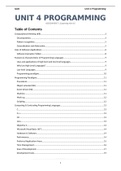Essay
Unit 4: Programming - Assignment 1 (P1, P2, P3, M1, D1)
- Course
- Institution
This document is the first assignment of Unit 4: Programming in BTEC. It consists of 49 pages (14,400+ words) that have met P1, P2, P3, M1 and D1 which is required to get the highest possible grade (Distinction) in Assignment 1 (Learning Aim A). I have explained, analysed & evaluated effectively ho...
[Show more]



